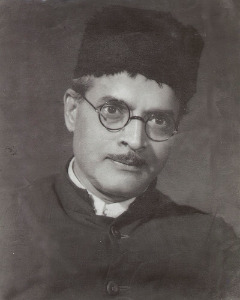Govindrao Tembe: A polymath
Respectfully known as Guni Govind in Maharashtra, the self-taught musician tried his hands at the various art of the industry — each time with a resounding success

Maharashtra has truly been the birthplace of Indian film industry. When Lumiere brothers screened their one-minute-duration films at Watson Hotel on July 18, 1996, nearly 200 people saw this marvel unfolding before their eyes after paying a hefty sum of two rupees. Though the event inspired several individuals from different parts of India to make films, Maharashtra led from the front. The film Industry was greatly enriched by Maharashtrian stalwarts like RG Torney, Dada Saheb Phalke, Baburao Painter, Bhalji Pendharkar, V Shantaram, VG Damle, Sheikh Fattelal and Master Vinayak.
Until 1931, only silent films were made. The era of talkies would set off only after the release of Ardeshir Irani-directed 'Alam Ara' on March 13, 1931. Kolhapur-based Prabhat Film Company, which had produced several silent films by then, also stepped forward with its talkie 'Ayodhya Ka Raja' in both Hindi and Marathi under the direction of V Shantaram. The person who played a vital role in making of the film was Govindrao Tembe.
Born on June 5, 1881 in Maharashtra's Kolhapur district, Govind Sadashiv Tembe was inclined towards music since his childhood. The largely self-taught musician was an excellent Harmonium player. He received his initial training in Hindustani classical music at Deval club, and later improved his musical skills under the guidance of Bhaskarbuwa Bakhale. Though he always considered himself as the disciple of Ustad Alladiya Khan of Jaipur Gharana, he never learned from him in person.
Tembe had a theatrical background. His music in Marathi play 'Manapman', was widely appreciated. Govindrao played lead roles in various stage plays directed by Bal Gandharava, all of which gained extreme popularity among audiences. He proved out to be a heart winner as an actor and a singer. He even started his own company, 'Shivraj Natak Mandali' in 1915, for which he gave music and wrote dramas, songs and dialogue. After the closure of the Mandali in 1925, Tembe focused on performing at musical concerts.
Producer-director V Shantaram spotted the genius in Kolhapur and offered him to join Prabhat Film Company as music director. During the re-hearsals of 'Ayodhya ka Raja', V Shantaram was not satisfied with the person in the lead role in the film; he gave the role to Tembe, making him the first hero of talkies in Marathi language. Tembe also wrote the songs and composed the music for both Hindi and Marathi versions. Of over the dozen songs he composed for the film, Tembe himself sang six numbers — both solos and duets.
The next film of Prabhat's music director was 'Jalti Nishani' (1932) for which he composed 15 numbers. 'Maya Machhindra' (1932) was his yet another hit in which he acted opposite Durga Khote. In 1933, Govindrao Tembe did two films for Prabhat – 'Sinhagad' and 'Sairandhri'.
Govindrao Tembe sang all the songs of the Marathi movie 'Sinhagad' except a Powada (ballad like composition). It is said that his music in this film was overshadowed by his own dialogues.
'Sairandhri' was the first Indian colour film produced in both Marathi and Hindi. The film flopped because of its defective colour technique. Yet, few numbers of Marathi version became popular. After bringing success to the films he did for Prabhat, Tembe left the company with the release of 'Sairandhri'.
Thereafter, he went to Calcutta in 1933 and joined Eastern Film Company. He played the role of Valmiki, and sang four songs, in Debaki Kumar Bose's 'Seeta' (1934) in which Prithviraj Kapoor and Durga Khote were lead actors. Tembe, however, returned to Kolhapur and joined Shalini Cinetone. He composed music for the films 'Usha', 'Raj Mukut' (1935) and 'Aseer-e-Hayat' and 'Pratibha' (1936) under Shalini Cinetone.
In 1938, Govindrao Tembe established his own production house, Natraj Film Company and produced films in Marathi and Hindi. Parshwanath Altekar-directed 'Soungadi' (Marathi) and 'Saathi' (Hindi), based on a story written by Mama Varerkar, were released in 1938 under the banner. The cast included Durga Khote, Bimla Serdesai and Mubarak. The films couldn't do well and the company was closed in 1939.
In his five-decade long glorious career, Govindrao Tembe gave music in Marathi, Hindi and Urdu films. He wrote lyrics for all of these films ex-cept his own production in Hindi, 'Saathi'. Tembe used almost identical tunes in Marathi and Hindi except his all-time-great numbers of 'Maya Machhinder' — Marathi number "Tarak mandla" and "Chhod akaash ke sitare" in Hindi. Overall, Tembe composed 115 film songs based on classical ragas. He was last seen in film 'Krishna Sudama' (1947) as an actor.
Govindrao Tembe solely focused on music during his last days. He also penned several articles and wrote two books in Marathi — Maza Sangeet Vyasang (My musical pursuits) and Maza Sangeet Vihar (My Musical journey). Apart from this, HMV brought out a number of records of his Harmonium play. Tembe also participated in several musical concerts.
During the first week of October 1955, the 74-year-old musician suffered a severe heart attack while attending the Board meeting of All India Radio in Delhi. He breathed his last on October 9. A week-long music festival, arranged in his honour, was attended by veteran musicians such as Bal Gandharva, Master Krishnarao and Padma Shaligram. Govind RaoTembe is addressed as Guni Govind as a mark of respect.
Views expressed are personal



